
A sex-determination system is a biological system that determines the development of sexual characteristics in an organism. Most organisms that create their offspring using sexual reproduction have two common sexes and a few less common intersex variations.

The Y chromosome is one of two sex chromosomes in therian mammals and other organisms. Along with the X chromosome, it is part of the XY sex-determination system, in which the Y is the sex-determining because it is the presence or absence of Y chromosome that determines the male or female sex of offspring produced in sexual reproduction. In mammals, the Y chromosome contains the SRY gene, which triggers development of male gonads. The Y chromosome is passed only from male parents to male offspring.

Voles are small rodents that are relatives of lemmings and hamsters, but with a stouter body; a longer, hairy tail; a slightly rounder head; smaller eyes and ears; and differently formed molars. They are sometimes known as meadow mice or field mice in North America.

The Arvicolinae are a subfamily of rodents that includes the voles, lemmings, and muskrats. They are most closely related to the other subfamilies in the Cricetidae. Some authorities place the subfamily Arvicolinae in the family Muridae along with all other members of the superfamily Muroidea. Some refer to the subfamily as the Microtinae or rank the taxon as a full family, the Arvicolidae.
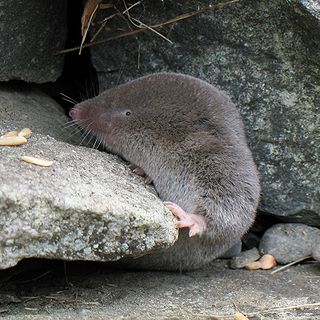
The northern short-tailed shrew is the largest shrew in the genus Blarina, and occurs in the northeastern region of North America. It is a semifossorial, highly active, and voracious insectivore and is present in a variety of habitats like broadleaved and pine forests among shrubs and hedges as well as grassy river banks. It is notable in that it is one of the few venomous mammals. The specific epithet, brevicauda, is a combination of the Latin brevis and cauda, meaning "short tail".
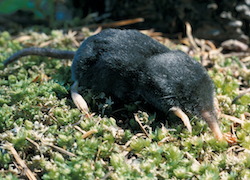
The American shrew mole is the smallest species of mole. It is the only living member of the genus Neurotrichus and the tribe Neurotrichini. It is also known as Gibb's shrew mole and least shrew mole. It is not closely related to the Asian shrew mole. The reason that it is called a "shrew mole" instead of being called either a "shrew" or a "mole" is because of its fur, which is a characteristic of shrews and its large head and heavy dentition, which is characteristic of moles.

The singing vole, is a medium-sized vole found in northwestern North America, including Alaska and northwestern Canada.

The woodland vole is a small vole found in eastern North America. It is also known as the pine vole.
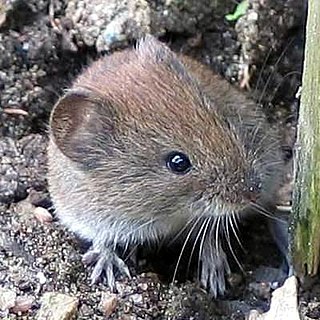
The bank vole is a small vole with red-brown fur and some grey patches, with a tail about half as long as its body. A rodent, it lives in woodland areas and is around 100 millimetres (3.9 in) in length. The bank vole is found in much of Europe and in northwestern Asia. It is native to Great Britain but not to Ireland, where it has been accidentally introduced, and has now colonised much of the south and southwest.

The Damaraland mole-rat, Damara mole rat or Damaraland blesmol, is a burrowing rodent found in southern Africa. Along with the smaller, less hairy, naked mole rat, it is a species of eusocial mammal.

The reed vole is a species of vole. It is found in northern and central Eurasia, including northern China and the Korean Peninsula. This species is somewhat larger and longer-tailed than most other voles.

Ellobius is a genus of rodents in the family Cricetidae. It contains two of the handful of examples of mammal species that have lost the Y chromosome.
The southern mole vole is a species of rodent in the family Cricetidae. It is found in Afghanistan, Iran, Pakistan, and Turkmenistan.

The Transcaucasian mole vole is a species of rodent in the family Cricetidae.
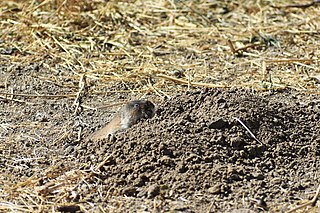
The Zaisan mole vole, or eastern mole vole, is a species of rodent in the family Cricetidae. It is found in central Asia.

Brandt's vole,, also known as the steppe vole, is a species of rodent in the family Cricetidae. It is native to shrublands and grasslands in Russia, Mongolia and northern China.
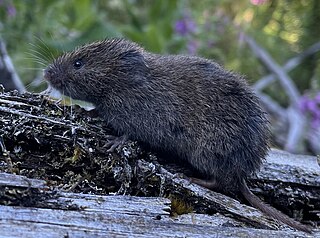
The creeping vole, sometimes known as the Oregon meadow mouse, is a small rodent in the family Cricetidae. Ranging across the Pacific Northwest of North America, it is found in forests, grasslands, woodlands, and chaparral environments. The small-tailed, furry, brownish-gray mammal was first described in the scientific literature in 1839, from a specimen collected near the mouth of the Columbia River. The smallest vole in its range, it weighs around 19 g. At birth, they weigh 1.6 g, are naked, pink, unable to open their eyes, and the ear flaps completely cover the ear openings. Although not always common throughout their range, there are no major concerns for their survival as a species.

The wood lemming is a species of rodent in the family Cricetidae. It belongs to the rodent subfamily Arvicolinae, so is a relative of the voles, lemmings, and muskrats. It is found in the taiga biome of China, Estonia, Finland, Mongolia, Norway, Russia, and Sweden.
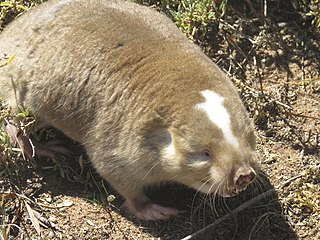
The Cape dune mole-rat is a species of solitary burrowing rodent in the family Bathyergidae. It is endemic to South Africa and named for the Cape of Good Hope.

The Tokunoshima spiny rat is a rodent found only on the island of Tokunoshima in the Satsunan Islands of Japan. Due to its small habitat, it is considered endangered. It is commonly found in the secondary and primary subtropical moist broadleaf forests of this island. The karyotype has an odd diploid number, 2n = 45. Like its relative T. osimensis, it is one of the few mammals that lack a Y chromosome and SRY gene.




















